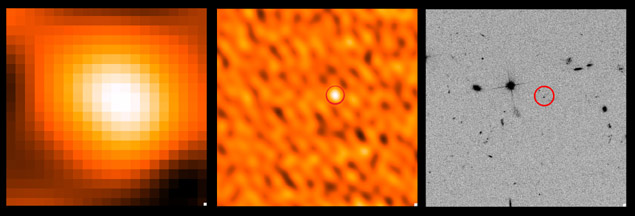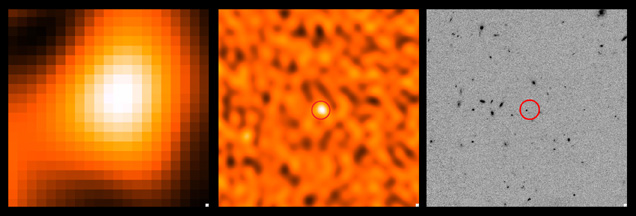Image List
-

The AzTEC submillimeter camera detected this bright source (left) in a region of the sky studied by the Cosmic Evolution Survey. The high resolution of the Smithsonian’s Submillimeter Array pinpointed the source of submillimeter radiation (center). A visible-light image by the Hubble Space Telescope (right) shows only a faint point that is barely detectable. Combined, these data show that the source in question is a very bright, but very distant and dusty galaxy that existed when the universe was less than 2 billion years old.
Left – UMass Amherst / Middle – Harvard-Smithsonian CfA / Right – COSMOS/ACS Team -

The AzTEC submillimeter camera detected this bright source (left) in a region of the sky studied by the Cosmic Evolution Survey. The high resolution of the Smithsonian’s Submillimeter Array pinpointed the source of submillimeter radiation (center). A visible-light image by the Hubble Space Telescope (right) detected nothing in the area of interest. Combined, these data show that the source in question is a very bright, but very distant and dusty galaxy that existed when the universe was less than 2 billion years old.
Left – UMass Amherst / Middle – Harvard-Smithsonian CfA / Right – COSMOS/ACS Team -

The AzTEC submillimeter camera detected this bright source (left) in a region of the sky studied by the Cosmic Evolution Survey. The high resolution of the Smithsonian’s Submillimeter Array pinpointed the source of submillimeter radiation (center). A visible-light image by the Hubble Space Telescope (right) shows only a faint point that is barely detectable. Combined, these data show that the source in question is a very bright, but very distant and dusty galaxy that existed when the universe was less than 2 billion years old.
Left – UMass Amherst / Middle – Harvard-Smithsonian CfA / Right – COSMOS/ACS Team